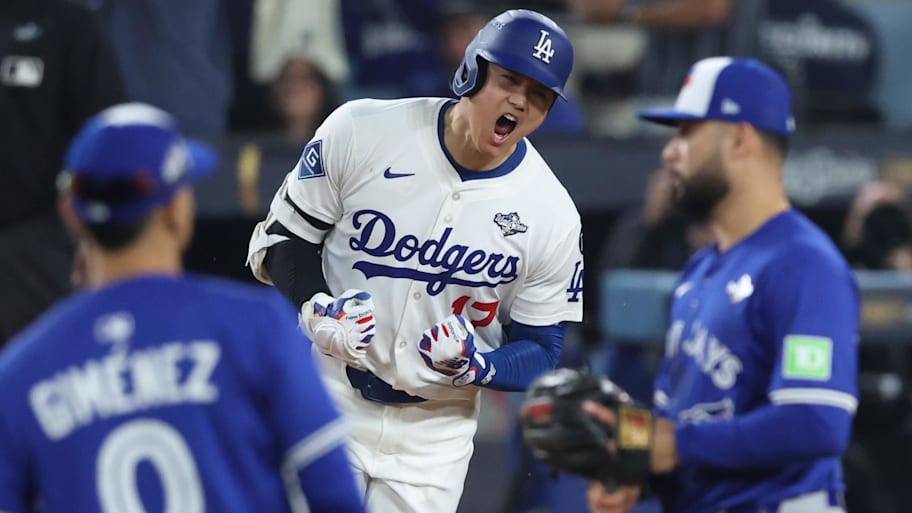LOS ANGELES — The digital clock on the wall of the Dodgers’ clubhouse read 12:10 a.m., only 20 minutes after the most exhausting World Series game ever played, and Shohei Ohtani, hair tousled and uncombed from a quick towel dry, clad in shorts and a T-shirt, hurried out a back door. His first World Series start on the mound was approaching later the same day, just 17 hours away.
Maybe Ohtani was headed toward a phone booth to restore his superpowers. Or maybe he is the modern Chiron, the centaur whom the ancient Greeks believed when wounded by Hercules invented modern medicine to heal himself.
We know not how he does it. All we know is that those 17 hours, like the eye of a hurricane, define the sheer wonder of Ohtani as definitively as the whirlwind of what he does on the field. Somehow after reaching base nine times in the 18 innings of madness that was Game 3—three more times than anybody ever did in a postseason game—and refusing to leave the game as cramps wracked his legs, Ohtani planned to take the ball as the starting pitcher in Game 4.
The Dodgers outlasted the Blue Jays, 6-5, on a merciful home run by Freddie Freeman that put an immediate stop to 18 innings, 19 pitchers, 31 hits, 399 minutes, 595 pitches and innumerable thrills, many of which were the consequences of awful baserunning and shaky fielding interspersed with moments of grandeur. It was a night you needed the organist to sign off with Handel’s “Hallelujah Chorus,” the way Fenway Park’s John Kiley did 50 years and six days previous when Carlton Fisk presaged Freeman. But nothing rose above the sublime and the ridiculous like the industriousness and unique greatness of Ohtani.
When I asked him on the field immediately after the game how he felt, he said quietly, “I need to go to bed.” The most active game anybody ever played in the World Series was played by the next day’s starting pitcher. Just the idea of that, like most everything Ohtani does, was unfathomable until he came along.
Shohei Ohtani reached base NINE times during tonight's 18-inning marathon.
— MLB (@MLB) October 28, 2025
He is scheduled to start Game 4 in under 18 hours.
What's his mindset? 😴😴😴 pic.twitter.com/XMoXWspj1p
“I mean, I threw two innings, and I feel like I’m dead,” Dodgers reliever Emmet Sheehan said. “So, it’s really just a testament to everything he does behind the scenes, like taking care of his body. He’s one of a kind. And yeah, if anybody can do it, play a game like that and pitch the next day, it’s him.”
Shohei Ohtani’s Record-Setting Night
Running a depleted staff, Dodgers manager Dave Roberts has little choice but to stick with Ohtani on the mound for Game 4. Given how exhausted and hobbled Ohtani looked over the back half of Game 3, maybe Roberts would do well to allow him to pitch only—and give him some rest while somebody else takes his DH spot. But such an impact hitter is Ohtani that giving his four or five—or nine—plate appearances to anybody else is doing the Toronto Blue Jays a favor.
How is this for spending the day before your start on the mound:
- First player to reach base nine times in a postseason game.
- First player in 119 years to swat four extra-base hits in a World Series game.
- First player with a third multi-homer game in one postseason.
- First player with four intentional walks in one postseason game.
By the 11th inning, so worn out was Ohtani that Roberts, upon seeing him dead-legged hobble from first to second, offered to take him out of the game to rest for his Game 4 start on the mound. Ohtani told him he wasn’t going anywhere.
“It’s really crazy to put it in words what he did,” said Dodgers infielder Miguel Rojas, “but the biggest thing is he didn’t want to come out of the game. He got the opportunity to. When he was cramping and he was feeling discomfort on his legs, he got the opportunity to come out of the game knowing that he needs to pitch tomorrow.
“But he talks a lot about like the commitment and the effort that everybody’s doing. Like he’s seeing his teammates out there and the pitchers going extra mileage, like a guy [pitcher Will Klein] who maybe never threw more than 25 pitches or 30 pitches in a game in his life. With Shohei, that’s kind of like his aura and who he is. He will never come out of the game because he wanted to win today. And regardless of what happened tomorrow, we got this one. And that’s the most important part.”

Right there in the gallantry department with Ohtani, Klein, Freeman and exhausted catcher Will Smith, who caught all 18 innings and blocked more pitches than a Hollywood show-runner, was Yoshinobu Yamamoto. Only two days earlier, the 5-foot-10 Yamamoto became the smallest pitcher to post a World Series complete game win since Billy Pierce of the 1962 Giants. Yet around the 16th inning, just after Roberts told me he would have to use a position player after Klein, Yamamoto, still with his sneakers on, approached pitching coach Mark Prior in the dugout with the interpreter Will Ireton. He volunteered to pitch in relief.
Indeed, Yamamoto put his spikes on and reported to the bullpen to warm. He was only one pitch away from entering the game in the 18th as a spent Klein went to a 3-and-1 count on Tyler Heineman with runners at second and third and two outs. Suddenly from the dugout, Kershaw, who had left the bases loaded in the 12th by getting a third-out grounder, yelled for time from home plate umpire Mark Wegner. Roberts heard Kershaw and doubled down on the request.
Klein, they claimed, needed to have the mud cleaned from his spikes. The timeout seemed to be designed to give Yamamoto more time to get ready and/or provide a breather to Klein after Smith already had visited the mound. Not so, Kershaw said.
“It wasn’t a gambit,” Kershaw said. “I saw he was slipping on the mound. I didn’t want him to slip while throwing a pitch.”
WILL KLEIN IS NASTY. #WORLDSERIES pic.twitter.com/d50jBe4XCm
— Los Angeles Dodgers (@Dodgers) October 28, 2025
In any case, Klein, given his break, fanned Heineman. If Klein throws Ball 4 there, Yamamoto is in the game and channeling Orel Hershiser, vintage 1988. In the 1988 NLCS, Hershiser saved Game 4 the day after starting Game 3, in which he threw seven innings on three days of rest after throwing 8 1/3 innings in Game 1. (He would throw a shutout in Game 7 on three days of rest, pitching four times in nine days.)
Blue Jays’ Questionable Moves Cost Them
The Dodgers outlasted the Blue Jays as much as they beat them. Toronto hurt itself with unforgivable mistakes. There was Isiah Kiner-Falefa tryng to go from first to third with one out in the ninth on a ball that caromed off the glove of Freeman and into short right field. Kiner-Falefa, with the ball behind him, never picked up the third base coach and decided wrong-headedly to just keep booking toward third. Second baseman Tommy Edman threw him out.
There was manager John Schneider replacing Addison Barger and Alejandro Kirk for pinch-runners, which, after an injury to George Springer and the removal of Bo Bichette to save his sore left knee, left a lineup nearly half full of bench players. Sending Myles Straw to run for Barger in the eighth was particularly baffling. The upgrade was miniscule. Both are plus runners. The downgrade in offense in a one-run game was huge. The game seemed continually to wheel toward Straw, Heineman and Kiner-Falefa, who went a combined 0-for-11 off the bench.
Most egregiously of all was the one pitch that reliever Seranthony Domínguez threw to Ohtani in the seventh when the Blue Jays were up 5–4 with two outs to go before turning to Jeff Hoffman for a six-out save. Such a dangerous hitter is Ohtani that pitching coach Pete Walker ran to the mound to warn Domínguez to give Ohtani nothing to hit with the bases empty. No sooner had Walker returned to the dugout than Domínguez threw a fastball right down the middle. Ohtani clocked it for a game-tying home run.
SHOHEI OHTANI'S SECOND HOMER OF THE NIGHT
— MLB (@MLB) October 28, 2025
TIE GAME! #WORLDSERIES pic.twitter.com/eA6h6saLnV
Schneider walked him intentionally four times after that homer, five if you count a pitch-around walk. Ohtani has not been swinging the bat well as he tried mostly for pull-side fly balls. He had not had an opposite field hit in 37 days.
But in the sixth, Mason Fluharty did him the favor of throwing him six straight sweepers—10 straight since they met in Game 1. The left-handed break of the pitch forced Ohtani to let the ball travel and to keep his front shoulder tucked on the ball longer. He smashed the 10th straight sweeper into left-center for a ringing double. It was exactly the kind of swing Roberts had been waiting for all month. It was the swing that locked in Ohtani, who after that looked like transformed, confident hitter not to be messed with.
Freeman won the game but Ohtani, fully dangerous again, swung the series. Schneider can no longer have his pitchers challenge him in any meaningful spot.
It wasn’t just that no game like the one Ohtani forged had never happened before. Four extra-base hits and nine times on base by the next day’s starting pitcher? Come on, folks. It is also stunning that no one even would think such a thing were possible.
Ohtani kept ducking into the clubhouse between at-bats to make sure he was hydrated and to treat his fatigue. At one point so haggard was Ohtani that he returned to the dugout wearing an alternate cap, one with a script “D” rather than the interlocking “LA.” A coach whispered in his ear, “Dude, you’ve got the wrong hat.” Ohtani spun on his heels and returned to his locker to get the proper one.
However, so restored was Ohtani as a hitting force that the Blue Jays did not allow him to swing the bat for the next three hours, 56 minutes after his home run off Domínguez. They put him on base five straight times with walks.
Ohtani did not reach full exhaustion. That was evident in a touching coda to his night. After celebrating with teammates greeting Freeman at home plate after the home run, Ohtani turned and began sprinting toward left field. Where was he going? Who was out there that would make him leave the mosh pit at home plate?

Ohtani remembered the sacrifice of Yamamoto, who did not get into the game but was willing to risk his health to make sure the Dodgers won this game. Yamamoto was jogging in from the bullpen when Ohtani, racing at near full speed, met him in the outfield. The two Japanese stars, the richest player and richest pitcher in history, playing under contracts worth $1.25 billion dollars, embraced like brothers on the grass in what was now the cool of the approaching midnight.
“Yama, he has like four or five championships already and counting, including Japan,” Rojas said. “He knows how to do it and what to do to get it done. So. I feel like he knows that a week from now we're going to be home and we're going to be resting. And he actually was ready to go and Doc was ready to put him in the game. And, I mean, I'm glad that Klein finished that inning and we’re here celebrating.”
Rojas spoke at a locker near to the one of Ohtani, who left only his vapor trail. Ohtani somehow had to recover in time from playing 18 innings to pitch 17 hours later. Said one Dodgers source, “People talk about elbow injuries to pitchers. With Shohei, what you worry most about is the wear and tear from what he is doing. People don’t appreciate the physical strain. Pitching alone is hard enough—the strain of it, the recovery it demands. And while he’s doing that, he’s playing every day. It’s the coast-to-coast travel. It’s the game after game. It’s everything. It’s constant.”
Babe Ruth found two-way duty so demanding he dropped it after two partial seasons of it. This is Ohtani’s sixth season doing it. He is doing so with extraordinary power more so than finesse and guile. Nobody has hit more balls 100 mph or more (220, including three more in Game 3). Only three starters have thrown more pitches 100 mph or more (46). If he takes his usual DH leadoff spot in Game 4, he will become the first pitcher to bat higher than sixth in the World Series, where the Babe hit in 1918.
Ohtani has had his elbow surgically repaired twice. There is an enormous physical toll he pays to pursue his love and to honor the gifts that make him the best player who ever lived. Enjoy every day of this wonder, especially the stupefying resolve of these back-to-back World Series games.
More World Series on Sports Illustrated
This article was originally published on www.si.com as After Game 3 Greatness, Shohei Ohtani Prepares Another Mythical World Series Feat.
